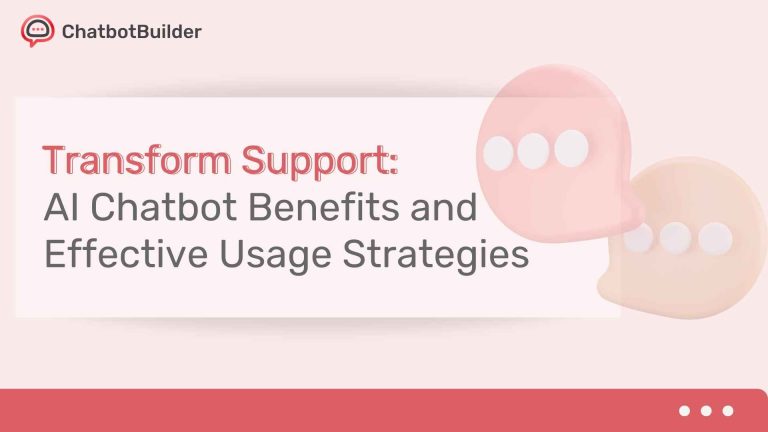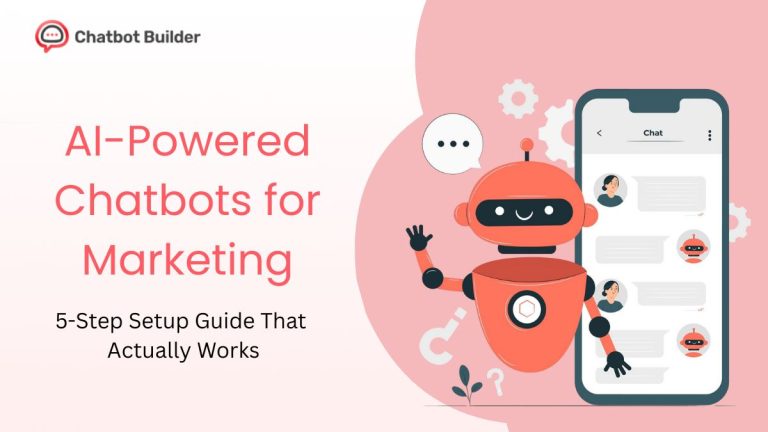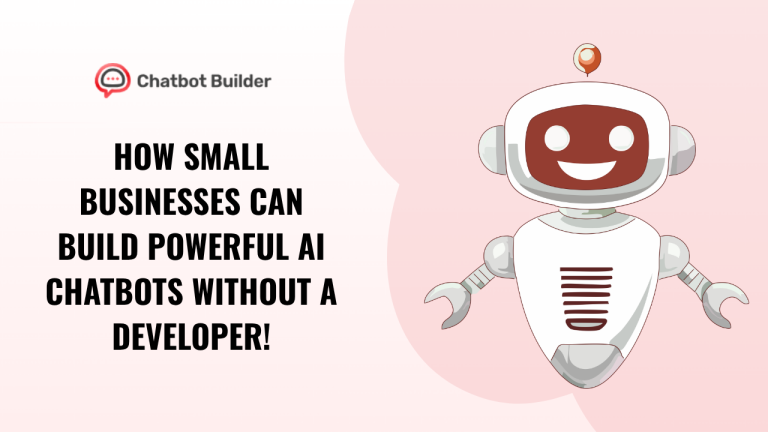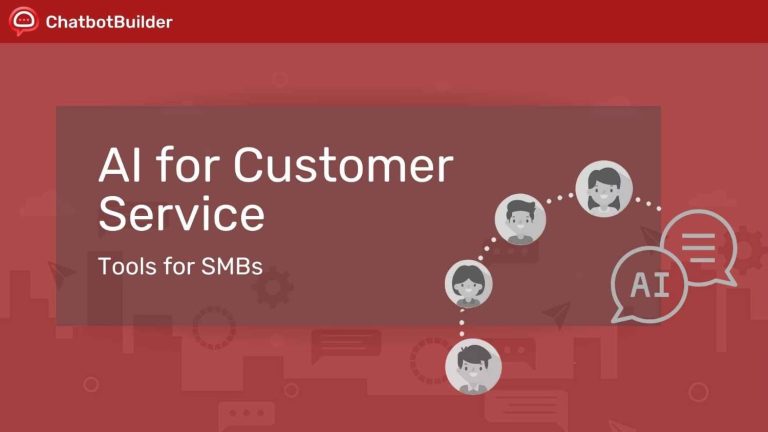Introduction: Why Most Chatbots Fail (And How These 10 Succeeded)
Picture this: You launch a chatbot expecting magic. Three months later, you’re staring at engagement rates that would make a rock look charismatic.
Sound familiar?
Here’s the brutal truth: 80% of chatbots get abandoned within the first month. Not because the technology is bad, but because most businesses treat chatbots like fancy FAQ pages instead of engagement powerhouses.
The companies I’m about to show you? They cracked the code.
They didn’t just build chatbots, but built digital employees that customers actually want to talk to. Whether you’re considering platforms like Outgrow’s chatbot builder, exploring ChatbotBuilder.net, or building custom solutions, the lessons from these 10 AI chatbot examples will save you months of trial and error.
Let’s dive into what works.
Why Chatbots Are No Longer Optional (The Numbers Don’t Lie)
The chatbot revolution isn’t coming. It’s here.
Here’s what most business owners miss: chatbots aren’t just replacing human agents. They’re creating entirely new ways to engage customers.
The Customer Expectation Shift
Your customers now expect instant responses. Not “within 24 hours.” Not “by end of business day.” Instant.
- 90% of customers expect immediate responses to customer service questions
- 64% of internet users say 24/7 availability is the best chatbot feature
- Companies using chatbots see 35% faster issue resolution times
- 67% of millennials expect to solve problems through chat
The Business Impact Reality
Smart businesses are riding this wave instead of fighting it:
- Lead response time decreases from 12 hours to under 5 minutes
- Customer satisfaction scores increase by 25% when chatbots handle routine queries
- Sales teams spend 40% more time on high-value activities when bots handle qualification
The Competitive Advantage Window
Here’s the kicker: 73% of businesses still don’t have chatbots. That’s your window. Your competitors are probably still making customers wait for email responses, while you could be solving problems in real-time.
The question isn’t whether you need a chatbot. The question is how quickly you can deploy one that actually works.
The Psychology Behind High-Engagement Chatbots
Most chatbots fail because they’re built by tech teams who think like computers, not customers. The highest-performing bots understand human psychology first, technology second.
The Instant Gratification Principle
Humans are wired for immediate rewards. Every second of delay triggers micro-stress responses. The most successful chatbots tap into this by providing value within the first 10 seconds of interaction.
The Reciprocity Effect
When your bot gives something valuable upfront (like personalized recommendations or useful information), users naturally want to give something back.
The Progress Bias
People feel more engaged when they see progress toward a goal. The best chatbots break complex processes into small, achievable steps. Each completed step releases a small dopamine hit that keeps users engaged.
AI Chatbot Examples That Boosted Engagement
1. Outgrow’s Interactive Lead Generation Bot
Outgrow created an interactive chatbot that transforms boring lead capture forms into engaging conversations. Instead of asking for contact details upfront, the bot starts with value-driven questions about business challenges.
Their fitness assessment bot asks about workout preferences, goals, and current fitness level before recommending personalized plans and capturing lead information naturally within the conversation flow.
Results: 52% increase in lead conversion rates, 67% reduction in form abandonment, 78% of users complete the full assessment.
What We Can Learn From This Bot: Turn data collection into value exchange. Outgrow’s approach proves that people will share information when they receive something valuable in return. Instead of asking “What’s your email?” start with “What’s your biggest challenge?” and build trust before requesting contact details.
2. ChatbotBuilder.net Success Story
A dental practice using ChatbotBuilder.net‘s chatbot transformed its patient scheduling process. The bot handles appointment requests, sends reminders, and answers common questions about procedures and insurance.
The practice customized one of ChatbotBuilder.net’s chatbot templates for marketing to include their specific services, accepted insurance plans, and office hours.
Results: 59% increase in online appointment bookings, 43% reduction in no-shows, 71% decrease in phone calls for basic information.
What We Can Learn From This Bot: They configured human handoff for complex insurance questions while letting the bot handle routine scheduling. The real win? They measured what mattered to their practice. Start with proven frameworks, then customize based on your unique business objectives and customer journey.
3. Sephora’s Color IQ Assistant
Sephora’s chatbot doesn’t sell makeup. It solves the biggest problem in cosmetics: finding your perfect shade match.
The bot asks users to upload selfies, analyzes skin tone using AI, and recommends products with 94% accuracy. Users spend an average of 11 minutes interacting with the bot compared to 3 minutes on regular product pages.
Results: 76% increase in engagement, 23% higher conversion rates, 67% reduction in returns.
What We Can Learn From This Bot: Stop trying to sell everything to everyone. Pick one specific problem your customers face daily and solve it better than anyone else. Sephora could have built a general shopping bot, but they focused on the one thing that drives most beauty purchases: color matching. When you solve a real problem, engagement follows naturally.
4. H&M’s Style Assistant
H&M’s chatbot acts like a personal stylist, asking questions about occasions, preferences, and budget before curating outfit recommendations.
The bot learns from each interaction, getting better at predicting what users want. It can mix and match items from their current wardrobe with H&M pieces, creating complete looks.
Results: 61% engagement boost, 34% increase in average order value, 89% of users complete the styling quiz.
What We Can Learn From This Bot: Personalization isn’t just about using someone’s name. H&M’s bot gets personal by understanding style preferences, body type, and lifestyle. The more relevant your recommendations, the longer people engage. Build systems that remember and learn from every interaction.
5. Domino’s Dom Voice Ordering Bot
Domino’s took ordering pizza and made it feel like talking to a friend. Their voice-activated bot handles complex orders, remembers favorites, and even cracks jokes.
Users can order through Alexa, Google Assistant, or the Domino’s app using natural language. The bot processes 95% of orders without human intervention.
Results: 58% increase in digital engagement, 42% faster order completion, 71% of users prefer bot ordering over phone calls.
What We Can Learn From This Bot: Convenience wins every time. Domino’s didn’t just digitize ordering – they made it faster and easier than any alternative. When your bot saves people time and effort, they’ll choose it over human interaction. Focus on removing friction, not adding features.
6. Bank of America’s Erica
Erica helps customers check balances, pay bills, and understand spending patterns through simple text or voice commands. The bot proactively sends alerts about unusual spending or upcoming bills.
With over 32 million users, Erica handles more than 120 million client requests annually, learning from each interaction to provide better financial guidance.
Results: 54% increase in mobile app engagement, 67% reduction in call center volume, 89% customer satisfaction rate.
What We Can Learn From This Bot: Don’t wait for customers to ask for help. Erica’s proactive notifications about spending patterns and bill reminders create value before users even realize they need it. Build bots that anticipate needs, not just respond to them.
7. Marriott’s ChatBotlr
Marriott’s hotel chatbot handles everything from room service orders to local recommendations. Guests can request extra towels, book spa appointments, or get directions to nearby restaurants.
The bot integrates with hotel systems to provide real-time updates and connects with human staff when needed for complex requests.
Results: 63% increase in guest engagement, 45% reduction in front desk calls, 78% of users rate the experience as “excellent.”
What We Can Learn From This Bot: Context is king. Marriott’s bot knows exactly where guests are, what services are available, and what time zone they’re in. This location and situation awareness makes every interaction relevant. Your bot should understand not just what users want, but where they are in their journey.
8. KLM’s BlueBot (BB)
KLM’s Facebook Messenger bot handles booking confirmations, check-in reminders, boarding passes, and flight updates. The bot sends proactive notifications about delays or gate changes.
BB processes over 16,000 conversations weekly and has achieved a 40% success rate in resolving customer queries without human intervention.
Results: 59% increase in social media engagement, 51% reduction in customer service emails, 73% customer satisfaction score.
What We Can Learn From This Bot: Timing is everything. KLM’s bot reaches customers exactly when they need information – 24 hours before departure, when gates change, or when flights are delayed. Build systems that understand the urgency and timing of customer needs.
9. Whole Foods’ Shopping Assistant
Whole Foods’ chatbot helps customers find products, discover recipes, and get nutritional information. The bot can suggest meal plans based on dietary restrictions and create shopping lists.
Users can ask about organic alternatives, allergen information, or cooking substitutions, and the bot provides detailed, accurate responses.
Results: 66% increase in recipe page engagement, 43% boost in average basket size, 81% of users find the bot “very helpful.”
What We Can Learn From This Bot: Education drives sales. Whole Foods doesn’t just help people find products – they teach customers how to use them. When your bot provides genuine value and knowledge, people spend more time and money with your brand. Focus on making customers smarter, not just converting them.
10. Pizza Hut’s Ordering Bot
Pizza Hut’s chatbot works across multiple platforms – Facebook Messenger, Twitter, and their mobile app. The bot handles orders, tracks delivery, and suggests add-ons based on order history.
The AI can upsell intelligently, suggesting complementary items without being pushy. It remembers customer preferences and can reorder favorites with a single command.
Results: 68% increase in digital order value, 47% boost in repeat orders, 91% accuracy rate for order processing.
What We Can Learn From This Bot: Meet customers where they are. Pizza Hut’s bot works on the platforms people already use daily. Don’t force customers to download new apps or visit special websites. Integrate with their existing digital habits and make ordering feel natural.
How to Build Your First Chatbot Using ChatbotBuilder.net
Ready to create your own engagement-boosting chatbot? Here’s a step-by-step guide using ChatbotBuilder.net:
Step 1: Add Your Data Sources and Train Your Bot
The foundation of any effective AI sales assistant is quality data. With ChatBot Builder, you have multiple ways to feed your bot crucial information:
- Add source links: Simply enter your website URL, and the platform will crawl and extract relevant information.
- Use native apps: Connect existing tools and platforms for seamless data integration.
- Import your sales knowledge base: Seamlessly upload documents, PDFs, and files containing your winning sales pitches, objection handlers, and product information.
- Direct text input: Type or paste information directly into the platform.
Pro Tip: Utilize the “Fetch link” feature to catch all the applicable links.
Step 2: Tailor the Look and Feel of Your Chatbot
ChatBot Builder makes it easy to create a visually consistent extension of your brand:
- Upload your logo for instant brand recognition
- Choose an avatar that reflects your sales approach
- Set a header name that engages visitors
- Select a color theme matching your brand palette
Step 3: Set Up Smart Sales Conversations
Set up automated replies for common questions, but also ensure your bot can handle complex inquiries by accessing its knowledge base. The key is balancing automation with intelligence.
Step 4: Configure Bot Settings for Tone, Language, and More
Fine-tune your chatbot’s personality and capabilities under the bot settings menu:
- Craft a bot name that resonates with customers and reinforces your brand identity
- Choose from numerous language options for global reach
- Set usage parameters to control conversation flow
- Tailor response length strategically
- Select the perfect tone (professional, friendly, helpful, etc.)
Step 5: Test, Deploy, and Optimize Across Channels
Before launching, thoroughly test your sales chatbot:
- Run through common customer scenarios
- Test objection handling capabilities
- Check response times and conversation flow
Once refined, deploy your AI sales assistant across all relevant channels—website, social media, messaging platforms—wherever your customers are seeking information.
The ROI of Chatbot Implementation: What to Expect
Let’s talk numbers. Real businesses are seeing real returns from chatbot investments, but the timeline and metrics vary based on the implementation approach.
Immediate Returns (0-3 Months)
- 40-60% reduction in response time
- 25-35% decrease in customer service workload
- 15-25% improvement in lead capture rates
- 20-30% increase in after-hours engagement
Medium-Term Gains (3-12 Months)
- 50-75% boost in customer engagement
- 30-45% improvement in conversion rates
- 60-80% reduction in routine support tickets
- 35-50% increase in customer satisfaction scores
Long-Term Transformation (12+ Months)
- 200-400% ROI on chatbot investment
- 70-90% of customer queries are handled automatically
- 40-60% increase in sales team productivity
- 25-40% improvement in customer lifetime value
Common Chatbot Mistakes That Kill Engagement
Learning from failures can be as valuable as studying successes. Here are the engagement-killing mistakes I see repeatedly:
The Kitchen Sink Approach: Trying to make your bot do everything on day one. The most successful AI chatbot examples started with one specific use case and expanded gradually.
The Robotic Personality: Using overly formal language that makes interactions feel cold. Your bot should match your brand voice, whether that’s professional, friendly, or playful.
The Information Hoarder: Asking for contact details before providing any value. The best AI chatbot examples give first, ask second.
The Dead-End Creator: Building conversation flows that trap users without escape routes. Always provide paths to human support or alternative solutions.
The Set-and-Forget Mentality: Launching without monitoring or optimization plans. The highest-performing bots are constantly evolving based on user feedback and behavior data.
The Platform Jumper: Switching between different chatbot platforms every few months. Pick one platform (like ChatbotBuilder.net or Outgrow) and master it before considering alternatives.
Building Your Own Engagement-Boosting Chatbot
These examples share common threads: they solve real problems, understand context, and make life easier for customers. Whether you’re using ChatbotBuilder.net’s proven templates or Outgrow’s interactive approach, focus on these principles:
Choose the Right Platform for Your Needs
ChatbotBuilder.net excels at traditional chatbot functionality that you can easily customize and deploy. Their platform works great for appointment booking, lead qualification, and customer support scenarios.
Outgrow’s chatbot builder takes a different approach, focusing on interactive experiences that feel more like personalized assessments than standard chat. Their platform excels at creating engaging quizzes and evaluations that naturally lead to sales conversations.
Core Success Principles:
Start with one specific use case. Don’t try to build a bot that does everything. Pick your customers’ biggest pain point and solve it completely.
Build for conversation, not commands. People want to talk naturally, not memorize syntax. Your bot should understand intent, not just keywords.
Use data to get smarter. Every interaction teaches you something about customer behavior. Build systems that learn and improve automatically.
Integrate with existing systems. Your bot should connect with your CRM, inventory, and customer service tools. Isolated bots create isolated experiences.
Test relentlessly. What works for Sephora might not work for your audience. Run A/B tests on everything – conversation flows, personality, timing, and features.
Conclusion: Your Next Move
The AI chatbot examples above didn’t just increase engagement by accident. They studied their customers, identified friction points, and built solutions that made interactions genuinely better.
Your bot doesn’t need to be perfect on day one. It needs to be useful. Start small, measure everything, and iterate based on real user behavior. The companies seeing 50%+ engagement boosts aren’t using magic. They’re using data, empathy, and smart design to create experiences people want to use.
Whether you choose ChatbotBuilder.net for quick deployment, Outgrow’s chatbot builder for interactive experiences, or build a custom solution, the principles remain the same: solve real problems, understand context, and make life easier for your customers.
The question isn’t whether chatbots work. These 10 examples prove they do. The question is: what problem will your chatbot solve, and how quickly can you start building it?
Your customers are waiting. Don’t keep them waiting much longer. Start building AI chatbots for your customers today with Chatbot Builder!
Frequently Asked Questions About AI Chatbot Examples
Not necessarily. Platforms like ChatbotBuilder.net offer no-code solutions with drag-and-drop builders and ready-made templates. However, the most successful implementations often involve some technical integration with existing systems like CRMs or inventory management.
Trying to do too much at once. The most successful AI chatbot examples in this article solved one specific problem really well, rather than attempting to handle every possible customer interaction. Start focused, then expand based on user behavior and feedback.
Yes, but make it authentic to your brand. AI chatbot examples like Domino’s bot cracks jokes because pizza ordering should be fun. Bank of America’s Erica is professional because people want confidence with their finances. Match your bot’s tone to your industry and customer expectations.
Build smooth handoff processes for human agents. The best AI chatbot examples recognize their limitations and transfer complex issues gracefully. Never leave users stuck in bot loops – always provide an easy path to human support.
Track these key metrics: conversation completion rate, average session duration, user return rate, conversion rate from bot interactions, and customer satisfaction scores. The most successful bots in our examples focused on one primary metric that aligned with their business goals.













